Vehicle registration plates of Germany
German vehicle registration plates (Kraftfahrzeug-Kennzeichen or, more colloquially, Nummernschilder) indicate the place where the vehicle bearing them was once registered. Whenever German owners of a motor vehicle change their main place of residence within Germany or buy a car from a person living in a different city or county they have to have the vehicle documentation changed accordingly. In the process owners may opt for new license plates that reflect their place of residence or simply retain the old identifier and plates. The states of Hesse, Schleswig-Holstein, Brandenburg, Saxony, Thuringia and North Rhine-Westphalia were the first ones to create laws so that owners were not obliged anymore to change license plates if they were changing residence within the respective state. A nationwide law has since been passed by the federal government and went into effect on January 1, 2015.[1] From this time on, it is generally not possible anymore to tell the owner's place of residence just from looking at the plates.
The option to be assigned temporary plates allows owners a financial saving in the case they have vehicles (e.g. motorcycles) which they intend to drive only during one particular part of the year. While temporary plates can only be used for the time printed on them and new ones have to be assigned and bought if the vehicle is supposed to be on public roads later on there is no need to renew regular plates periodically. German motor vehicle tax is paid independently of the license plates by annual direct debit from a bank account.
As of 2007, new number plates normally cost around €30, while the cost of de-registering a vehicle and re-registering it with new plates is between €10 and €40. The license plates themselves are not made by the registration office but by independent for-profit stores that are usually located in the same building as the registration office or close by. Upon successful registration the applicant is merely given a slip of paper with the assigned number that can be presented at any store that makes plates. Sometimes there are several stores in the vicinity of the registration office with prices for plates dropping the further the store is away from the registration office. Once the plates are made, which is a matter of minutes, the owner must return to the registration office with them, pay the costs for registration and then the required registration seal and safety test stickers are applied to the plates making them legal for use in traffic.
If ownership of a vehicle is permanently transferred to a new owner who lives in the same city/region then the registration number may remain unchanged. Administration fees are, however, still payable in respect of the necessary changes to the vehicle's official documentation. Many people however will change the license plates even if it is not necessary in order to personalize them.
Format
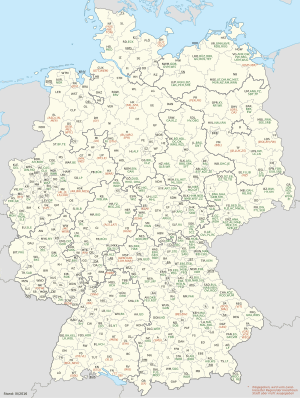
The present German number plate format has been in use since 1994. As with many plates for countries within the European Union, a blue strip on the left shows a shortened country code in white text (D for Deutschland = Germany) and the Flag of Europe (12 golden stars forming a circle on a blue background).
The rest of the license plate uses black print on a white background. Just after the country code strip is a one, two or three letter abbreviation, which represents the city or region where the car was registered, such as B for Berlin. These letters formerly coincide with the German districts. Since 2013 the letters were extended to former districts (complete list). In some cases an urban district and the surrounding non-urban district share the same letter code. Where this happens, the number of the following letters and digits is usually different. For example, the urban district of Straubing (SR) has one letter after the code (SR - A 123). The surrounding district Straubing-Bogen has two letters (SR - AB 123) after the code. However, these different systems are being used in fewer cases, as many cities that share their code with the surrounding rural districts have started using all codes for both districts without any distinction; the city of Regensburg, for example, and the surrounding rural district Regensburg used different systems only until 2007.
The number of letters in the city/region prefix code mostly reflects the size of the district. The basic idea was to even out the number of digits on all license plates, because the largest districts would have more digits after the prefix for more cars. The largest German cities generally only have one letter codes (B=Berlin, M=Munich, K=Cologne (Köln), F=Frankfurt, L=Leipzig, S=Stuttgart), most other districts in Germany have two or three letter codes. Therefore, cities or districts with fewer letters are generally assumed to be bigger and more important. Reflecting that, most districts tried to get a combination with fewer letters for their prefix code.
Districts in eastern Germany usually have more letters, for two reasons:
- Fewer people live in eastern German districts, so the number of cars registered is smaller and hence the use of three letter codes.
- With the introduction of the current system on 1 July 1956 in then West Germany including Berlin (West), letters had been reserved for all east German districts of that time. However, a lot of those districts were changed over the years, and in 1990 after German reunification, many of the possible shorter combinations had already been used up in western Germany.
There are a number of exceptions e.g. Germany's second largest city Hamburg (HH, Hansestadt Hamburg, because of its historical membership in the Hanseatic League, reflected already in its prefix used between 1906 and 1945). Similar is the case of the cities of Bremen and Bremerhaven, forming the state Free Hanseatic City of Bremen, sharing the common prefix HB (1906–1947, and again since 1956), differentiated by the number of letters and digits added.
In 1956 Lübeck also received its former prefix HL, already used between 1906 and 1937, when its statehood was abolished. In analogy to these three northwestern cities, but without historical examples of formerly issued prefixes, four northeastern Hanseatic cities, Greifswald, Rostock, Stralsund and Wismar, chose the prefixes HGW, HRO, HST and HWI, since the shorter HG (Hochtaunuskreis, capital: Bad Homburg vor der Höhe), HR (Schwalm-Eder-Kreis, capital: Homberg (Efze)), HS (Kreis Heinsberg) and HW (Kreis Halle in Westphalia) were already taken by west German districts.
More west German districts have prefixes derived from the names of their capitals: Ammerland (WST, after Westerstede), Dithmarschen (HEI, after Heide in Dithmarschen), Harburg (WL, after Winsen upon Luhe), Herzogtum Lauenburg (RZ, after Ratzeburg) etc.
The letter "G" was reserved for the east German city of Gera, although it is much smaller than the west German Gelsenkirchen ("GE"). The letter "L" had been reserved for Leipzig, but in 1977 it was assigned to the newly formed city of Lahn, and the rural district Lahn-Dill-Kreis. This casts some light on how unlikely a reunification was regarded at that time. In 1990, Leipzig claimed back the letter "L", and it was reassigned, and Lahn-Dill-Kreis had to change to LDK.
The reason for this scheme is however not to display size or location, but simply to have enough combinations available within the maximum length of eight characters per plate.
After the location name there are the round vehicle safety test and registration seal stickers (see below) placed above each other. The registration sticker is the bottom one. For vehicles that are required to bear a front and rear plate the front plate nowadays only features the registration seal sticker. Before 2010, in which year the emission test became a part of the vehicle safety test, the hexagonal emission test sticker was placed above it. The stickers are followed by one or two usually random letters and one to four usually random numbers. The total quantity of letters and numbers on the plate is never higher than eight. Identifiers consisting of one letter with low numbers are normally reserved for motorcycle use since there is less space for plates on these vehicles.
A problem with this scheme is that the space between geographic identifier and random letters is a significant character and must be considered when writing down a number. For example, B MW 555 is not the same number as BM W 555. The confusion can be avoided by writing a hyphen after the city code, as in the old number plates, like B-MW 555. For this reason, the police will always radio the location name and spell out the next letters using the German telephone alphabet, which varies somewhat from the English one. Thus, B MW 555 would be radioed as "Berlin, Martha, Wilhelm, fünf-fünf-fünf" and BM W 555 as "Bergheim, Wilhelm, fünf-fünf-fünf".
For an extra charge of €10.20 car owners can also register a personalized identifier. Car owners can only choose the numbers or letters instead of the random ones at the end, provided of course they are not yet taken and not a prohibited combination. For example, people living in the town of Pirna might choose PIR-AT 77, "Pirat" being the German for "pirate". Kiel is one of few places (others are Brake (capital of the district of Wesermarsch), Cham, Daun, Emden, Halle, Hamm, Heide, Herne, Hof, Kleve, Kusel, Lauf, Lünen, Pirna, Plön, Regen, Rehau, Selb, Ulm, Unna and Wesel) where the number plate can be the city name: 'KI-EL'. In most cases of personalized plates people choose their initials and a number reflecting their birthdate. In this fashion fictional Mrs. Ulrike Mustermann, born May 2, 1965 and living in Essen would choose 'E UM 2565' for her car. Note that dates are given in the format DDMMYY in Germany.
Germany includes diacritical marks in the letters of some codes, that is the letters Ö and Ü. Such a thing is rarely done in other European countries, but also appears on regular Bosnian, Croatian and Serbian(letters Č, Š and Ž), Åland registration plates (letter Å), as well as on Swedish (letters Å, Ä and Ö) and Danish (letters Æ, Ø and Å) personal registration plates. In Germany there are no two codes where the only difference is that one letter O and Q, the only pair of codes with the letters I and J is IL for Landkreis Ilmenau and JL for Landkreis Jerichower Land.
BMW, owner of Mini, registers all Mini press/marketing cars in the city of Minden, which holds the code MI, to get "MI-NI" number plates for the cars. BMW itself is based in Munich, yet "M-INI" plates are not possible to issue, as three letters after the district code are not permitted.
Prohibited combinations
Various combinations that could be considered politically unacceptable — mainly due to implications relating to Nazi Germany — are disallowed or otherwise avoided.[2] The district Sächsische Schweiz used the name of its main town, Pirna, in its code PIR, to avoid the use of SS, the name of the paramilitary organization; similarly SA is also unused. Although between 1945 and 1949 the French occupation force used the combination SA followed by the double-digit numbers 01 to 08 for the then seven rural districts in the Saar Protectorate and its capital Saarbrücken. In 2004 in Nuremberg, a car owner was refused a number plate beginning N-PD because of the connection to the political party the NPD. The combinations STA-SI, HEI-L, IZ-AN and WAF-FE are also avoided, to avoid association with Stasi, the Nazi salute, NAZI backwards and the Luftwaffe respectively.
Banned combinations also include the Nazi abbreviations HJ (Hitlerjugend, Hitler Youth), NS (Nationalsozialismus, National Socialism), SA (Sturmabteilung), SS (Schutzstaffel), KZ (Konzentrationslager, concentration camp) and often SD (Sicherheitsdienst). Some registration offices have overlooked this rule by mistake, however, and there are a few cars registered carrying prohibited codes, such as B-SS 12. Some counties also allow these combinations if they are the initials of the owner (e.g., Norbert Schmidt might be able to get XX-NS 1234), but in this case, if the car is sold and re-registered in the same county by the new owner, the number can be changed (otherwise the number stays with the car until it registered in a different area). However, the combination HH (which could be interpreted as Heil Hitler) is used for the city of Hamburg, first introduced in 1906. It stands for the city's title Hansestadt Hamburg (Hanseatic City of Hamburg). The combination AH (which could be interpreted as Adolf Hitler) is used for the district of Borken. It is derived from Ahaus that had its own district until 1974.
In Brandenburg no new plates that are related to Hitler, the Hitler salute, other Nazi symbols, etc. can be issued, especially plates that have digits 1888, 8818, 8888 or ending in 88, 888, 188. The combinations AH 18 and HH 18 cannot also be issued to new owners.[3]
Other combinations affected are BUL-LE,[4] MO-RD[5] and SU-FF.[6]
History
The first German licence plates that had a lettering plan were issued from 1906 onwards. Berlin for example was using I A (I for Prussia), Munich II A (II for Bavaria), Stuttgart III A (III for Württemberg). Other German states used further Roman numbers such as IV (Baden), V (Hesse), and VI (Alsace-Lorraine; now France). Many states used prefixes derived from the state names, such as B (Brunswick), HB (Bremen), HH (Hamburg), and HL (Lübeck), the latter three used again for the same entities since 1956. Other bigger cities: IV B Baden (Heidelberg, Mannheim, Karlsruhe, Freiburg, Lake Constance), II N cities of Nuremberg and Fürth. The Prussian provinces had the following prefixes: I E Province of Brandenburg (to a minor part now Poland), I C Province of East Prussia (now divided between Lithuania, Poland and Russia), I S Province of Hannover, I T Province of Hesse-Nassau (Today Frankfurt, State of Hessen and neighboring counties), I L Province of Hohenzollern, I Z Rhine Province (Cologne, Düsseldorf and other large cities in the Ruhr Area), I H Province of Pomerania (now prevailingly Poland), I Y Province of Posen (now Poland), I B Province of Posen-West Prussia (now Poland), I M Province of Saxony, I P Province of Schleswig-Holstein, I K Province of Silesia (now mostly Poland), I X Province of Westphalia, and finally I D Province of West Prussia (now Poland).
During World War I the German Army was assigned the combination MK for "Militärkraftwagen des Deutschen Heeres", military vehicles of the German Army. After World War I, during the Weimar Republic, the German Army used RW for "Reichswehr".
During the Nazi regime (1933–1945) new combinations were issued: DR, Deutsche Reichsbahn (German state railway); OT, Organisation Todt (civil and military engineering); POL, Deutsche Polizei / "Orpo" (police); RAD, Reichsarbeitsdienst (state labour service); RK, Deutsches Rotes Kreuz (Red Cross); SS, Schutzstaffel ("protection squadron", using the doppelte Siegrune (double sig rune) insignia designed by Walter Heck in 1933); WH, Wehrmacht Heer; WL, Wehrmacht Luftwaffe (air force); WM, Wehrmacht Kriegsmarine (navy); WT, Wehrmacht Straßentransportdienst (army transport service).
From 1945 to 1956 there were lettering combinations assigned by the allied forces. Examples: BY Bavaria (Bayern) 1946–1947, AB Bavaria (American Zone, Bavaria) 1948–1956, B Bavaria 1950–1956. HE Hesse 1946–1947, AH Hesse (American Zone, Hesse) 1948–1956, H Hesse, 1950–1956. AW Württemberg-Baden 1948–1956, W Württemberg-Baden, 1950–1956, WB Württemberg-Baden 1950–1956. БM (=BM, for motor bikes) 1945–1946, ГФ (=GF; cars, lorries, and busses) Berlin 1945–1946, БГ (=BG; cars, lorries, and busses) Berlin 1945–1947, ГM (=GM, for motor bikes) Berlin 1945–1947, KB Berlin 1947–1948, GB East-Berlin 1948–1953, KB West-Berlin 1948-1956. MGH Hamburg 1945, H Hamburg 1945–1947, HG Hamburg 1947, BH Hamburg 1948–1956. BD Baden 1945–1949, FB Baden 1949–1956. WT Württemberg-Hohenzollern 1945–1949, FW Württemberg-Hohenzollern 1949–1956.
In July 1956 the current system was introduced in then West Germany, replacing the post-war system which was based on occupation zones.
As West German districts were extensively rearranged in the early 1970s, many prefix codes expired and new ones were created at that time. However, number plates issued before these rearrangements remain valid, providing the vehicle is still in use and has not been reregistered since. So it was still possible, if rare, to see a classic car with registration codes of administrative units that have not existed for over 30 years (e.g. EIN = Einbeck). Since November 2012 some districts allow reissuing on request of these expired prefix codes, e.g. instead of WES- in the district of Wesel, MO- as used for the former district of Moers and DIN- as used for the former district of Dinslaken.
When originally planned, the system included codes for districts in Eastern Germany which were to be reserved until reunification. That included the territory of the GDR as well as the territories annexed to Poland and the Soviet Union after World War II, which West Germany's government still claimed in that era until about 1970. When reunification came in 1990, the reserved codes (e.g. P for Potsdam) were indeed issued to East German districts in January 1991 as originally planned and as they existed at that time. However, districts in East Germany were rearranged again in the mid-1990s, thus many of these codes have expired, but can likewise still be seen on older vehicles.
One example of a reserved code being reused before reunification was the letter L which was originally planned for Leipzig, but was given to the newly formed Hessian city of Lahn and the district Lahn-Dill-Kreis in 1977 as hopes for reunification faded away. After the rather unexpected reunification the L was returned to the city of Leipzig and the Lahn-Dill-Kreis was issued with LDK instead.
Another reserved code was G for Gera. In the 1980s the West German TV series "Der Fahnder" G was an imaginary large city in the Ruhrgebiet area.
Typeface
Modern German plates use a typeface called FE-Schrift ("fälschungserschwerende Schrift", tamper-hindering script). It is designed so that the O cannot be painted to look like a Q, and vice versa; nor can the P be painted to resemble an R, among other changes. This typeface can also more easily be read by optical character recognition software for automatic number plate recognition than the old DIN 1451 script.
Special codes
Certain types of vehicle bear special codes:
- Classic cars (known in German by the pseudo-English expression Oldtimer) can get an H (historisch, historic) at the end of the plate, such as K-AA 100H in order to preserve the so-called "vehicle of cultural value" ("kraftfahrtechnisches Kulturgut"). It also includes a flat tax of appr. €190 per year. It is popular to choose the digits so that they indicate the car's year of manufacture. The requirements for a vehicle for an H-Plate are:
- The first documented registration lies at least 30 years in the past.
- The car must be in mostly original and preservation worthy condition. Preservation worthy means a grade C by popular car grading standards. The older the car, the more signs of usage it can show. This purely concerns the car's appearance, the road worthiness is established by separate mandatory safety inspections. Universally accepted modifications include changes that benefit safety, such as seat belts and disc brakes, and environmental friendliness, such as catalytic converters and LPG conversions (if invisible from the outside). Further modifications that are generally accepted are those contemporary of the car's first registration (plus and minus 10 years, burden of proof lies with the owner through historic material such as photographs) and new paintjobs of any color, including two tone paint if originally offered and historic company logos, but no murals or custom patterns.
- Plug-in electric vehicles. The 2015 Electric Mobility Act authorized issuing special license plates for plug-in electric vehicles to allow proper identification to avoid abuses of these privileges.[7][8] The special license plate adds the letter "E" at the end of the license number. Owners of all-electric cars and plug-in hybrids with a minimum all-electric range of 30 km (19 mi) can apply for the special license. The minimum range for eligible plug-in hybrids goes up to 40 km (25 mi) from January 1, 2018.[9][10]
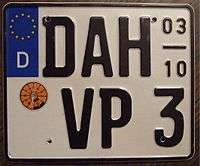
- Cars (or more often, motorbikes) with seasonal number plates have two numbers at the end of the plate indicating the months between which they are registered to drive, with the licence being valid from the start of the upper month until the end of the lower month. This results in lower car taxes, as well lower insurance premiums.
- Until the legal reforms of 2006, Official cars such as police, fire fighting and municipality vehicles did not carry a letter after the sticker, such as M-1234. These included:
- vehicles of the district government: 1-199, 1000-1999, 10000-19999
- vehicles of the local government (for example: fire brigade): 200-299, 2000-2999, 20000-29999, 300-399
- police: 3000-3999, 7000-7999, 30000-39999, 70000-79999
- disaster relief (mostly changed "THW", see below): 8000-8999, 80000-89999
This style of plate is no longer issued, but many official vehicles which were registered before 2006 still carry this type of plate.
A similar style of issue is used by some municipalities to consular or diplomatic vehicles in the form Aaa-9NNn (example: D-921). Unlike the other style of diplomatic/consular plates issued in Berlin and Bonn, this plate does not indicate the nationality of the mission.
- Vehicles which are exempt from vehicle taxes (for example ambulances, tractors, agricultural trailers, trailers for boats or trailers for gliders) have green print on a white background plate. Regular trailers for lorries can be exempted from tax if the owner agrees to pay an increased tax on the vehicle which tows the trailer. There is also a tax exemption for trailers for which the owner agrees to hand over his trailer without payment to the armed forces (if Germany is in a state of emergency or defence).
- Vehicles which have not been registered (because they are for transfer within Germany) have to carry short-term plates valid only for five days. The code starts with the numbers 04, e.g. DD-04000, and the plate has a yellow strip on the right showing when they are valid. The date is listed numerically, on three lines, reading day, month, year, with two digits each. The vehicle need not have a valid technical inspection, however it must be technically fit to be operated in public. Insurance premiums are quite high, appr. €100 for the above-mentioned 5 days. Most insurance companies credit this premium if the car is registered as a normal car with the same insurance company after these 5 days.
- Car dealers' plates are in red print on a white background, and the code begins with 06. Red plates may be attached to cars which are changing hands, such as the test run of unregistered cars, and the liability insurance is connected to the plate, not a specific car.
- Car collectors: Red plates starting with the number 07 are reserved for collectors of vintage cars. Originally, vintage cars had a required minimum age of 20 years from first registering. Since April 2007 onwards the required minimum age has been 30 years. Plates issued under the old 20 years rule remained valid after this date. The collectors must get an official certificate of approval (such as no criminal records). They are allowed to use one set of plates on any of their cars under the condition that they keep a strict record of use. No day-to-day use of the cars is allowed. A valid official technical inspection is not mandatory but the cars have to be technically fit for use on public roads.
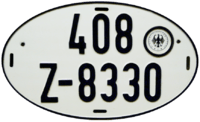
- Export plates (also known as "Ausfuhrkennzeichen", customs plates) are used for exporting vehicles abroad. The plates are the only ones which do not have the blue Euro strip on the left and the owner does not have to be a German resident to register the car. The date on the red strip on the right hand side does not show the expiration date of the plate; instead it shows the expiration date of the vehicle insurance. After this date the vehicle must have left Germany.
- Diplomatic plates: plates of cars covered by diplomatic immunity have the digit 0 (Zero) on the left instead of the registration location code.
- Highest state offices: The President uses the license plate 0-1, the Chancellor uses 0-2, the Foreign Minister uses 0-3 and the First State Secretary of the Foreign Office (i.e. the Foreign Minister's deputy) uses 0-4. The President of the Parliament uses 1-1. This reflects the fact that the Parliament's President is not part of the executive branch but still ranks higher in (symbolic) importance than the Chancellor. These vehicles are tax-exempt and need not to be insured since the German government acts as insurer.
- The military uses old style non-reflecting plates with a dash between the two circles. The German flag is shown, instead of the blue EU strip. Military plates use the letter Y, rather than a city indicator (no German city name starts with a Y). After the Y comes a six-digit number (or five digits for motorcycles), for example Y-123456. These vehicles are tax-exempt and need not to be insured since the German government acts as insurer. There is also no mandatory technical inspection required but the Armed Forces carry out a regular internal inspection on these vehicles similar to the official inspection.
- Military vehicles which are used by the Nato headquarters in Germany use the same design as the Y-plates except they carry the letter X followed by a four-digit number, for example X-1234
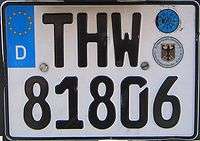
- Some branches of the federal government and federal state governments use the abbreviations of their names instead of a city code. Example: the Technisches Hilfswerk (German Federal Agency for Technical Relief) uses its abbreviation THW, so the plates read THW-80000, for example. All numbers on THW plates start either with the digit 8 or 9. Before the Deutsche Bundesbahn (German National Railways) and the Deutsche Bundespost (Federal Post Office) were privatised, they used the abbreviations DB and BP (e.g. DB-12345, BP-12345). The Wasser- und Schifffahrtsverwaltung des Bundes (Federal Water and Ship Transport Authority) uses BW followed by a digit identifying the region of the office (from 1=north to 7=south).
- The federal police uses the code BP instead of the local code. Before 2006 they used the code BG (former name: Bundesgrenzschutz) (BG-#####), this old code remains still valid, only new vehicles will get the new "BP"-code.
- The Police of North Rhine-Westphalia uses NRW 4, NRW 5 and, for motorbikes, NRW 6 as the local code. This is followed by a four-digit number (e.g. NRW 4-1960). 4, 5 and 6 stand for the State Ministry of the Interior.
- Light motorised vehicles such as mopeds and motorised wheelchairs are required to have a registration plate, see next section.
Insurance plates

The Versicherungskennzeichen ("insurance plate" ) used for mopeds and other small, low-power vehicles (such as vehicles for the physically handicapped, with a maximum speed of 50 km/h, 31 mph). The system is three digits on the top and three letters beneath. The number and the letters are chosen randomly so personalizing the plates is not possible. Plates are much smaller than the plates for normal cars and are only valid for one year from 1 March till the end of February the following year. Those plates are sold by insurance companies, so the fee included both the registration, and the cost of one year's insurance for the vehicle. There are four colours used: black, blue, green for normal plates, and red for temporary use, such as testing (very rare). The first three colours are changed every year in order to make it easy to see whether the vehicle has the correct plate and insurance.
Colours of the insurance plates from 1 March onwards of each year Colour Year RAL 9005 (Tiefschwarz, Jet black) 1990 1993 1996 1999 2002 2005 2008 2011 2014 RAL 5012 (Lichtblau, Light blue) 1991 1994 1997 2000 2003 2006 2009 2012 2015 RAL 6010 (Grasgrün, Grass green) 1992 1995 1998 2001 2004 2007 2010 2013 2016
Emission, safety test and registration sticker
Emission test (front plate) and vehicle safety test (rear plate) stickers were also attached to the plate before 2010, in which year the emission sticker became obsolete as the emission test was incorporated into the safety test and was not performed separately any more. The expiration date can be figured out as follows: The year is in the centre of the sticker, and the stickers are attached with the month of expiration pointing upwards. The black marking on the side (near the 12) thus makes it easy for the police to see the expiration month from a distance. Like a clock, the marking shows the same position of a number on the face of a clock. For example, the black marking is on the left side, so it is the ninth month (or 9 o'clock) and hence the expiry date is 30 September. The six possible colors code for the year when the next safety test is due and repeat once a six-year period has passed.
The lower sticker is the official seal of registration. It always carries the seal of the respective German Bundesland with the city or district of issuance being added in print. Some seals carry the German Bundesadler instead of a Bundesland's seal, such as numberplates used on Bundespolizei vehicles.
All these stickers are specially treated to be easily transferred onto the licence plates, but hard to be removed without damaging the plate itself, making them relatively counterfeit-proof.
Cars found in a public place where the owner did not pay insurance for more than three months (as reported to the police by the insurance company) may get entstempelt, that means, unstamped: The police will remove the state's official seal using a scratching tool (mostly a screwdriver), leaving the plate without a valid seal, and it will be illegal to even leave that car parked on public ground, unless insurance is paid and plates are fitted with a new official seal.
Once a plate is invalid, the seal of registration is defaced by a qualified officer. After that, the plates are often sold to collectors on online shopping sites, such as eBay.
When owners choose to deregister their vehicle the officer at the local authority will want to see the license plates with defaced seals on them as proof that no legal plate with this identifier can be found in public anymore. For this purpose special machines are available for use at the office. Once defaced the plates may only be used legally on public roads for the one ride back to the owner's place. This is the recommended procedure for selling a car. Alternatively the seller may hand out their car with valid license plates and papers still in their name to the new owner thus giving them the responsibility to register the car in their name shortly. In a scenario without a proper sales contract the seller may become liable when the buyer commits criminal acts related to the car or plates and thus it is generally not recommended to sell used cars with license plates.
Motorcycles carry only the rear plate.
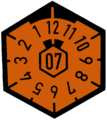 Emission test sticker (before 2010)
Emission test sticker (before 2010)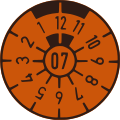 Safety test sticker
Safety test sticker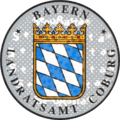 Registration seal (Coburg, Bavaria)
Registration seal (Coburg, Bavaria) Safety test and registration seal (Fürth, Bavaria)
Safety test and registration seal (Fürth, Bavaria)
| Colour | Year | ||||||||
|---|---|---|---|---|---|---|---|---|---|
| RAL 2000 (Gelborange, Yellow-orange) | — | 1979 | 1983 | 1989 | 1995 | 2001 | 2007 | 2013 | |
| RAL 5015 (Himmelblau, Sky blue) | — | 1978 | 1984 | 1990 | 1996 | 2002 | 2008 | 2014 | |
| RAL 1012 (Zitronengelb, Lemon yellow) | — | 1977 | 1985 | 1991 | 1997 | 2003 | 2009 | 2015 | |
| RAL 8004 (Kupferbraun, Copper brown) | 1974 | 1980 | 1986 | 1992 | 1998 | 2004 | 2010 | 2016 | |
| RAL 3015 (Hellrosa, Light pink) | 1975 | 1981 | 1987 | 1993 | 1999 | 2005 | 2011 | 2017 | |
| RAL 6018 (Gelbgrün, Yellow-green) | 1976 | 1982 | 1988 | 1994 | 2000 | 2006 | 2012 | 2018 | |
See also
- Vehicle registration plates of the German Democratic Republic
- Vehicle registration plates of the United States Army in Germany
- Liste aller Kfz-Kennzeichen der Bundesrepublik Deutschland (German) List of all registration codes issued under the current registration system
- Liste der deutschen Kfz-Kennzeichen, die nicht mehr ausgegeben werden (German) List of no longer issued registration codes
- Liste der deutschen Kfz-Kennzeichen (historisch) (German) List of repealed registration codes
- Liste der Kfz-Kennzeichen in Deutschland (German) List of currently issued registration codes
References
- ↑ Verbraucherzentrale Nordrhein-Westfalen e.V. (2014-12-02). "Kfz-Kennzeichen: HH auch für Frankfurter". Retrieved 2014-12-09.
- ↑ M-AH 8888 ist durchgerutscht (German) Sueddeutsche Zeitung, published: 9 October 2015, accessed: 9 October 2015
- ↑ "Verschärfte Regeln gegen Nazi-Autokennzeichen" [Stricter rules against Nazi plates]. Rheinische Post (in German). 18 September 2010.
- ↑ "Autokennzeichen "BUL-LE" aus dem Verkehr gezogen" [Car plate sign "BUL-LE" withdrawn from circulation]. Die Welt (in German). 13 August 2013.
- ↑ "30 Moerser wollten Kennzeichen MO-RD" [30 Moers people wanted plate "MO-RD"]. Rheinische Post (in German). 13 November 2012.
- ↑ "Wunschkennzeichen Rhein-Sieg-Kreis" (in German).
- ↑ Staff (2015-03-06). "Elektromobilitätsgesetz:Bundestag beschließt Vorfahrt für E-Autos" [Electric Mobility Act: Bundestag passes priority for electric cars]. Spiegel Online (in German). Retrieved 2015-03-14.
- ↑ Staff (2015-03-05). "Bundestag will Vorfahrt für E-Autos" [Bundestag wants Priority for electric cars]. KFZ-betrieb (in German). Retrieved 2015-03-14.
- ↑ Staff (2015-09-29). ""E" wie Elektroauto" ["E" as electric car]. Autobild (in German). Retrieved 2016-10-23.
- ↑ Viehmann, Sebastian (2016-06-03). "E-Kennzeichen und ElektromobilitätsgesetzMit diesem Nummernschild parken Sie jetzt umsonst" [E-Marks and Electromobility Act: With this number plate you park now for free]. Focus (German magazine) (in German). Retrieved 2016-10-23.
External links
| Wikimedia Commons has media related to License plates of Germany. |
- German Number Plates, Also shows how they are made (saved 2011-12-21)
- History of German license plates
- More information about German car number plates and their history
- German City Codes, Complete City Code List
- Application to find which region/place in Germany the vehicle originates
- Photos of license plates of Germany